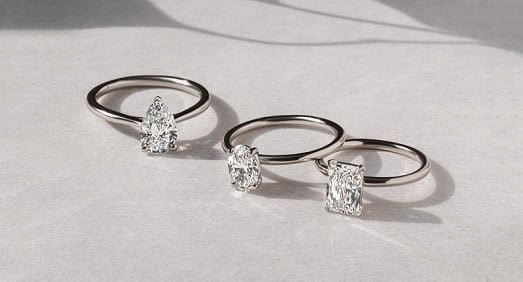When it comes to buying diamonds or other gemstones, there’s a lot to consider. Whether you’re purchasing an engagement ring, a statement necklace, or a simple pair of earrings, understanding key terms like carat, clarity, and color can help you make a more informed decision. These are known as the four Cs of gemstones, and each factor plays a crucial role in the quality and value of the jewelry piece. In this guide, we’ll break down each of these characteristics in a fun and easy-to-understand way, so you can feel confident in your next jewelry purchase.
What Is Carat in Jewelry?
When you hear the term carat, it often refers to the weight of a diamond or gemstone. A carat is equivalent to 200 milligrams, and it’s used to measure the size and weight of gemstones. You might be wondering, “Does carat size really matter?” Well, yes—carat is one of the most significant factors when determining a stone’s value. A larger carat weight generally means a higher price tag.
But remember, size isn’t everything! You’ll often find that a diamond with a high carat weight but poor clarity or color might not be as valuable Evry Jewels as a smaller, higher-quality stone. Carat weight is simply one piece of the puzzle when it comes to gemstone valuation.
How Does Carat Affect the Price?
It’s important to understand that carat weight doesn’t increase in a linear fashion. For example, a 1-carat diamond might cost less than a 2-carat diamond, but a 2-carat diamond doesn’t always cost twice as much. This is because carat weight is just one aspect of a gemstone’s overall value. Other factors like clarity and color will still play a significant role in how much a piece of jewelry costs.
The Importance of Clarity in Jewelry
Clarity refers to the presence of imperfections or blemishes within a gemstone. These imperfections, also known as “inclusions” (inside the stone) or “blemishes” (on the surface), can affect a diamond’s overall appearance and value. The clearer a gemstone, the more valuable it tends to be.
Different Clarity Grades
Gemstones, especially diamonds, are graded based on their clarity. These grades range from “Flawless” (FL), meaning the gemstone has no internal or external imperfections visible under 10x magnification, to “Included” (I1, I2, I3), where the inclusions are large enough to be visible to the naked eye. Here’s a quick breakdown of the common clarity grades:
- Flawless (FL): No internal or external imperfections visible under magnification.
- Internally Flawless (IF): No internal imperfections, but minor surface blemishes may be visible.
- Very, Very Slightly Included (VVSI): Inclusions are very difficult to see under magnification.
- Very Slightly Included (VSI): Inclusions are minor but can be seen with magnification.
- Slightly Included (SI1 & SI2): Inclusions are visible under magnification and sometimes with the naked eye.
- Included (I1, I2, I3): Inclusions are visible to the naked eye and can affect the gemstone’s overall appearance and durability.
The higher the clarity, the more valuable the gemstone. However, minor inclusions often don’t detract much from the beauty of the gemstone and are typically not visible without magnification. When shopping for a gemstone, consider whether you can see the inclusions with the naked eye or not. Sometimes, a clarity grade lower than “flawless” can still provide great value without sacrificing too much visual appeal.
Understanding Color in Jewelry
When it comes to color, diamonds and gemstones come in a wide range of shades, and the color can impact both the beauty and value of the stone. In diamonds, color refers to the absence of color—ideally, the more colorless a diamond, the more valuable it is. This is graded on a scale from D (colorless) to Z (light yellow or brown).
How Does Diamond Color Affect Its Value?
In diamonds, the best color is D, which means the diamond is completely colorless. These diamonds are the rarest and most expensive. As you move down the color scale, the diamond’s price generally decreases. For example, diamonds in the G to J range can still appear nearly colorless to the untrained eye, but they are less expensive than diamonds in the D to F range.
However, some people actually prefer slightly tinted stones, and the slight warmth of a K or L colored diamond can add a unique charm. Ultimately, the ideal color depends on your personal preference and budget.
Color in Other Gemstones
For non-diamond gemstones, color is often the most important factor in determining value. Gemstones like sapphires, rubies, and emeralds all have their own specific color grading systems. For example, in rubies, a vibrant red color is considered the most desirable, while in emeralds, a deep green with minimal yellow or blue undertones is typically the most valued.
Putting It All Together: Carat, Clarity, and Color
When shopping for diamonds or gemstones, keep in mind that carat, clarity, and color are just three of the main factors that determine the value of a piece of jewelry. Together, these factors affect the overall beauty and quality of a stone.
If you’re working within a budget, remember that you don’t have to settle for a low-quality gemstone. Sometimes, you can find a stunning diamond with a slightly lower carat weight or a small imperfection that’s invisible to the naked eye. Focus on the carat, clarity, and color that fit your personal taste and budget, and you’ll end up with a beautiful piece of jewelry that will last a lifetime.
So, the next time you’re browsing for jewelry, you’ll have a much better understanding of what’s behind the sparkle, making your decision a little easier and a lot more fun!
Read also: https://www.thefuturetoons.com/



